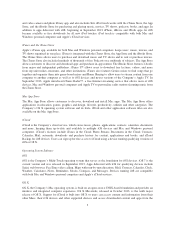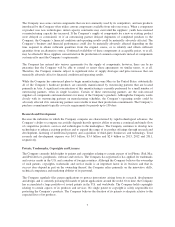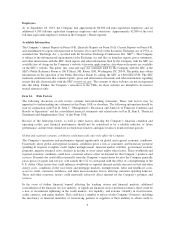Apple 2013 Annual Report Download - page 14
Download and view the complete annual report
Please find page 14 of the 2013 Apple annual report below. You can navigate through the pages in the report by either clicking on the pages listed below, or by using the keyword search tool below to find specific information within the annual report.carrying amount of an asset may not be recoverable. If the Company determines that impairment has occurred, it
records a write-down equal to the amount by which the carrying value of the assets exceeds its fair value.
Although the Company believes its provisions related to inventory, capital assets, inventory prepayments and
other assets and purchase commitments are currently adequate, no assurance can be given that the Company will
not incur additional related charges given the rapid and unpredictable pace of product obsolescence in the
industries in which the Company competes.
The Company must order components for its products and build inventory in advance of product announcements
and shipments. Consistent with industry practice, components are normally acquired through a combination of
purchase orders, supplier contracts, and open orders, in each case based on projected demand. Where
appropriate, the purchases are applied to inventory component prepayments that are outstanding with
the respective supplier. Purchase commitments typically cover forecasted component and manufacturing
requirements for periods up to 150 days. Because the Company’s markets are volatile, competitive and subject to
rapid technology and price changes, there is a risk the Company will forecast incorrectly and order or produce
excess or insufficient amounts of components or products, or not fully utilize firm purchase commitments.
Future operating results depend upon the Company’s ability to obtain components in sufficient quantities.
Because the Company currently obtains components from single or limited sources, the Company is subject to
significant supply and pricing risks. Many components, including those that are available from multiple sources,
are at times subject to industry-wide shortages and significant commodity pricing fluctuations. While the
Company has entered into various agreements for the supply of components, there can be no assurance that the
Company will be able to extend or renew these agreements on similar terms, or at all. The follow-on effects from
global economic conditions on the Company’s suppliers, described in “Global economic conditions could
materially adversely affect the Company” above, also could affect the Company’s ability to obtain components.
Therefore, the Company remains subject to significant risks of supply shortages and price increases.
The Company and other participants in the markets for mobile communication and media devices and personal
computers also compete for various components with other industries that have experienced increased demand
for their products. The Company uses some custom components that are not common to the rest of these
industries. The Company’s new products often utilize custom components available from only one source. When
a component or product uses new technologies, initial capacity constraints may exist until the suppliers’ yields
have matured or manufacturing capacity has increased. Continued availability of these components at acceptable
prices, or at all, may be affected if those suppliers decided to concentrate on the production of common
components instead of components customized to meet the Company’s requirements. The supply of components
for a new or existing product could be delayed or constrained, or a key manufacturing vendor could delay
shipments of completed products to the Company.
The Company depends on component and product manufacturing and logistical services provided by outsourcing
partners, many of whom are located outside of the U.S.
Substantially all of the Company’s manufacturing is performed in whole or in part by a few outsourcing partners
located primarily in Asia. The Company has also outsourced much of its transportation and logistics
management. While these arrangements may lower operating costs, they also reduce the Company’s direct
control over production and distribution. It is uncertain what effect such diminished control will have on the
quality or quantity of products or services, or the Company’s flexibility to respond to changing conditions.
Although arrangements with these partners may contain provisions for warranty expense reimbursement, the
Company may remain responsible to the consumer for warranty service in the event of product defects and could
experience an unanticipated product defect or warranty liability. While the Company relies on its partners to
adhere to its supplier code of conduct, material violations of the supplier code of conduct could occur.
The Company relies on sole-sourced outsourcing partners in the U.S., Asia and Europe to supply and
manufacture many critical components, and on outsourcing partners in Asia for final assembly of substantially all
12
























